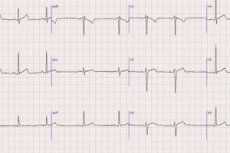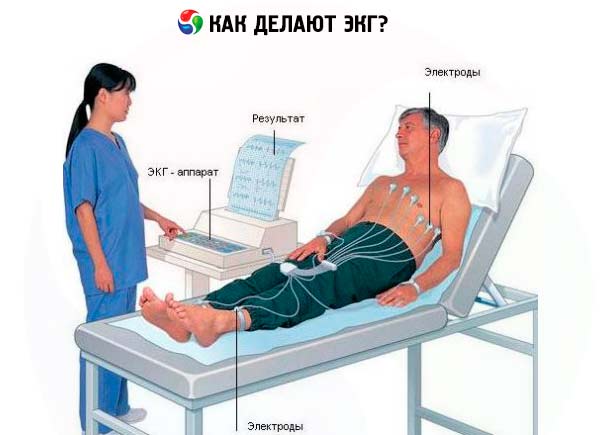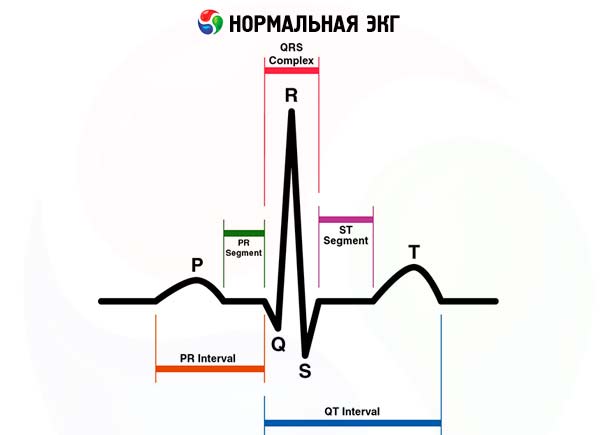Electrocardiography (ECG)
Last reviewed: 23.04.2024

All iLive content is medically reviewed or fact checked to ensure as much factual accuracy as possible.
We have strict sourcing guidelines and only link to reputable media sites, academic research institutions and, whenever possible, medically peer reviewed studies. Note that the numbers in parentheses ([1], [2], etc.) are clickable links to these studies.
If you feel that any of our content is inaccurate, out-of-date, or otherwise questionable, please select it and press Ctrl + Enter.

Electrocardiography is a study that remains out of the competition for its clinical significance. It is usually performed in dynamics and is an important indicator of the state of the heart muscle.
ECG is a graphic record of the electrical activity of the heart, which is recorded from the surface of the body. The change in the electrical activity of the heart is closely related to the summation of electrical processes in individual cardiac myocytes (cardiac muscle cells), the processes of depolarization and repolarization occurring in them.
Purpose of ECG
Determination of electrical activity of the myocardium.
Indications for ECG
A routine examination is performed by all patients hospitalized in an infectious hospital. Unplanned and emergency research is conducted with the development or suspicion of cardiac muscle damage toxic, inflammatory or ischemic.
ECG Research Methodology
Use an electrocardiograph with electronic amplifiers and oscilloscopes. The curves are recorded on a moving paper tape. Potentials from the extremities and the surface of the chest are taken to register the ECG. Usually three standard leads are used from the limbs: I leads - the right arm and the left arm, the II lead is the right arm and the left leg, the third lead is the left arm and the left leg. To divert the potentials from the chest, the electrode is applied to one of the six points on the chest by a standard procedure.

Contraindications to ECG
Electrocardiography with stress (stress-ECG) is contra- indicated in the acute period of infectious disease .
Electrophysiological basis of ECG
At rest, the outer surface of the cell membrane is positively charged. Inside the muscle cell, a negative charge can be detected with a microelectrode. When the cell is excited, depolarization occurs with the appearance of a negative charge on the surface. After a certain period of excitation, during which a negative charge is stored on the surface, a potential change and repolarization occur with the restoration of the negative potential inside the cell. These changes in the action potential are the result of movement through the membrane of ions, primarily Na. Na ions first penetrate into the cell, causing a positive charge of the inner surface of the membrane, then it returns to the extracellular space. The depolarization process quickly spreads through the muscle tissue of the heart. During the cell's excitation, Ca 2+ is transported inside of it, and this is considered as a probable link between electrical excitation and subsequent muscle contraction. At the end of the repolarization process, the K ions leave the cell, which at the very end are exchanged for Na ions that are actively extracted from the extracellular space. At the same time, a positive charge forms on the surface of the cell, which has passed into a state of rest.

The electrical activity recorded on the surface of the body with the help of electrodes is the sum (vector) of the processes of depolarization and repolarization of numerous cardiac myocytes in amplitude and direction. The excitation, that is, the process of depolarization, of the myocardium divisions proceeds sequentially, with the help of the so-called conducting system of the heart. There is, as it were, a wave front of excitation, which spreads gradually to all parts of the myocardium. On one side of this front, the cell surface is negatively charged, on the other side it is positive. The changes in potential on the surface of the body at various points depend on how this excitation front propagates through the myocardium and which part of the cardiac muscle is projected to a greater extent on the corresponding part of the body.
This process of propagation of excitation, in which positively and negatively charged sites exist in tissues, can be represented as a single dipole consisting of two electric fields: one with a positive charge, the other with a negative one. If a negative charge of the dipole faces the electrode on the surface of the body, the curve of the electrocardiogram goes down. When the vector of electric forces changes its direction and its positive charge is reversed on the surface of the body, the curve of the electrocardiogram goes in the opposite direction. The direction and magnitude of this vector of electrical forces in the myocardium depends primarily on the state of the muscle mass of the heart, as well as the points from which it is recorded on the surface of the body. The greatest value is the sum of the electric forces that arise during the excitation process, as a result of which the so-called QRS complex is formed. It is by these ECG teeth that the direction of the electrical axis of the heart can be assessed, which is also of clinical importance. It is clear that in more powerful parts of the myocardium, for example, in the left ventricle, the excitation wave extends for a longer time than in the right ventricle, and this affects the size of the primary tooth of the ECG-tooth R in the corresponding part of the body on which this myocardium is projected. When the electrically inactive regions consisting of connective tissue or necrotic myocardium form in the myocardium, the wavefront of the excitation wave curves around these areas, and at the same time to the corresponding part of the surface of the body it can be turned by its positive or negative charge. This entails the rapid appearance of multidirectional prongs on the ECG from the corresponding site of the body. If the excitation is not performed through the conduction system of the heart, for example, on the right leg of the bundle, the excitation to the right ventricle extends from the left ventricle. Thus, the front of the excitation wave, enclosing the right ventricle, "comes" in a different direction compared to its usual course (that is, when the excitation wave begins with the right leg of the Heis bundle). The spread of excitation to the right ventricle occurs at a later time. This is expressed in the corresponding changes in the R wave in the leads, to which the electric activity of the right ventricle is more projected.
An electric excitation pulse appears in the sinus-atrial node located in the right atrial wall. The impulse extends to the atrium, causing their excitation and contraction, and reaches the atrioventricular node. After some delay at this site, the pulse spreads along the bundle of His and its branches to the myocardium of the ventricles. The electrical activity of the myocardium and its dynamics, associated with the spread of excitation and its cessation, can be represented in the form of a vector that varies in amplitude and direction during the entire cardiac cycle. And there is an earlier excitation of subendocardial layers of the ventricular myocardium with the subsequent spreading of the excitation wave towards the epicardium.
The electrocardiogram reflects the successive coverage of the excitation of the myocardium. At a certain speed of the cardiogram tape along the intervals between individual complexes, it is possible to estimate the heart rate, and over the interval between the teeth, the duration of the individual phases of the cardiac activity. By voltage, i.e., the amplitude of individual ECG teeth recorded in certain areas of the body, it is possible to judge the electrical activity of certain parts of the heart and, above all, the magnitude of their muscle mass.
On the ECG, the first small amplitude wave is called the P wave and reflects depolarization and atrial excitation. The next high-amplitude complex of QRS reflects depolarization and excitation of the ventricles. The first negative tooth of the complex is called the tooth of Q. Following it, the upwardly-directed tooth R and the subsequent negative tooth S. If the second tooth behind the tooth 5 is directed upward, it is called the tooth R. The shape of this complex and the magnitude of its individual teeth upon registration with different parts of the body from the same person will be significantly different. However, it should be remembered that always the upward prong is the prong R, if it is preceded by a negative prong, then this is the tooth Q, and the subsequent negative tooth is the S tooth . If there is only one prong directed downward, it should be called QS tooth . To reflect the comparative value of individual teeth, use the large and small letters rRsS.
After the QRS complex, after a short period of time, the tooth T is followed , which can be directed upwards, i.e. Be positive (most often), but it can also be negative.
The appearance of this tooth reflects the repolarization of the ventricles, that is, their transition from the excitation state to the unexcited one. Thus, the QRST (Q - T) complex reflects the electrical systole of the ventricles. It depends on the heart rate and is normally 0.35-0.45 s. Its normal value for the corresponding frequency is determined by a special table.
Significantly more important is the measurement of two other segments on the ECG. The first is from the beginning of the P wave to the beginning of the QRS complex, ie, the ventricular complex. This segment corresponds to the time of atrial-ventricular conduction of excitation and is normally 0.12-0.20 s. When it increases, there is a violation of atrioventricular conduction. The second segment is the duration of the QRS complex, which corresponds to the time of the excitation propagation through the ventricles and is normally less than 0.10 s. With an increase in the duration of this complex, they speak of a violation of intraventricular conduction. Sometimes, after the T wave , a positive wave U is noted , the origin of which is associated with the repolarization of the conducting system. When registering the ECG, a potential difference is recorded between two points of the body, first of all it concerns standard leads from the extremities: lead I is the potential difference between the left and right hands; Lead II is the potential difference between the right hand and the left leg and the lead III is the potential difference between the left foot and the left arm. In addition, amplified leads from the extremities are recorded: aVR, aVL, aVF, respectively, from the right arm, left arm, left leg. These are so-called unipolar leads, in which the second electrode, inactive, is a connection of the electrodes from the other limbs. Thus, the change in potential is recorded only in the so-called active electrode. In addition, in standard conditions, an ECG is also recorded in 6 thoracic leads. The active electrode is superimposed on the chest at the following points: the V1 lead is the fourth intercostal space to the right of the sternum, V2 is the fourth intercostal space to the left of the sternum, V4 is at the apex of the heart, or the fifth intercostal space is slightly inside the middle dorsal line, V3 is in the middle of the distance between points V2 and V4, lead V5 - the fifth intercostal space in the anterior axillary line, V6 lead - in the fifth intercostal space along the middle axillary line.
The most pronounced electrical activity of the ventricular myocardium is found during their excitation, that is, depolarization of their myocardium - during the onset of the QRS complex. In this case, the resultant of the arising electrical forces of the heart, which is a vector, occupies a definite position in the frontal plane of the body relative to the horizontal zero line. The position of this so-called electrical axis of the heart is estimated by the magnitude of the QRS complex teeth in various leads from the extremities. The electric axis is considered to be unbent or occupies an intermediate position with the maximum tooth R in I, II, III leads (i.e., the tooth R is substantially larger than the S- tooth ). The electric axis of the heart is considered to be deviated to the left or horizontally located, if the voltage of the QRS complex and the magnitude of the R wave is maximal in the I lead, and in the III lead, the R tooth is minimal with a significant increase in the S wave . The electric axis of the heart is vertically or deflected to the right with the maximum tooth R in III lead and in the presence of pronounced S- wave in the I lead. The position of the electric axis of the heart depends on the non-cardiac factors. In people with high diaphragm standing, hypersthenic constitution, the electric axis of the heart is turned to the left. At high, lean people with a low diaphragm standing, the electric axis of the heart is normally deflected to the right, located more vertically. Deviation of the electrical axis of the heart can also be associated with pathological processes, the predominance of the mass of the myocardium, i.e. Hypertrophy of the left ventricle (left axis deviation) or right ventricle (deviation of the axis to the right).
Among the thoracic leads V1 and V2, the potentials of the right ventricle and the interventricular septum are recorded to a greater extent. Since the right ventricle is relatively low-power, the thickness of its myocardium is small (2-3 mm), the spread of excitation over it occurs relatively quickly. In connection with this, a very small R tooth and a subsequent deep and wide tooth S, associated with the propagation of the excitation wave along the left ventricle, are normally recorded in the V1 lead . V4-6 leads are closer to the left ventricle and reflect its potential to a greater extent. Therefore, in the leads V4-b the maximum tooth R is recorded , which is especially pronounced in the V4 lead, i.e., in the region of the apex of the heart, since it is here where the thickness of the myocardium is greatest and, therefore, the propagation of the excitation wave requires more time. In the same leads, a small tooth Q may also appear, associated with an earlier spread of excitation through the interventricular septum. In the middle precordial leads V2, especially V3, the size of the teeth R and S is approximately the same. If in the right thoracic leads V1-2 the teeth R and S are approximately the same, without other abnormalities, the rotation of the electric axis of the heart takes place with a deviation to the right. If the tooth R and the tooth S are approximately equal in the left thoracic leads , the deviation of the electric axis in the opposite direction takes place. Special mention should be made of the shape of the teeth in the lead aVR. Given the normal position of the heart, the electrode on the right hand is turned into the ventricle. In this connection, the shape of the complex in this lead will mirror the normal ECG from the heart surface.
When decoding the ECG, much attention is paid to the state of the isoelectric ST segment and the T wave . In most leads, the T wave must be positive, reaching an amplitude of 2-3 mm. This prong can be negative or smoothened in the lead aVR (as a rule), as well as in the leads III and V1. Segment ST, usually izoelektrichen, t. E. Stored at the isoelectric line between the end of the tooth T and the beginning of the next tooth F. A small rise of the ST segment may be in the right thoracic leads V1-2.
Read also:


 [
[